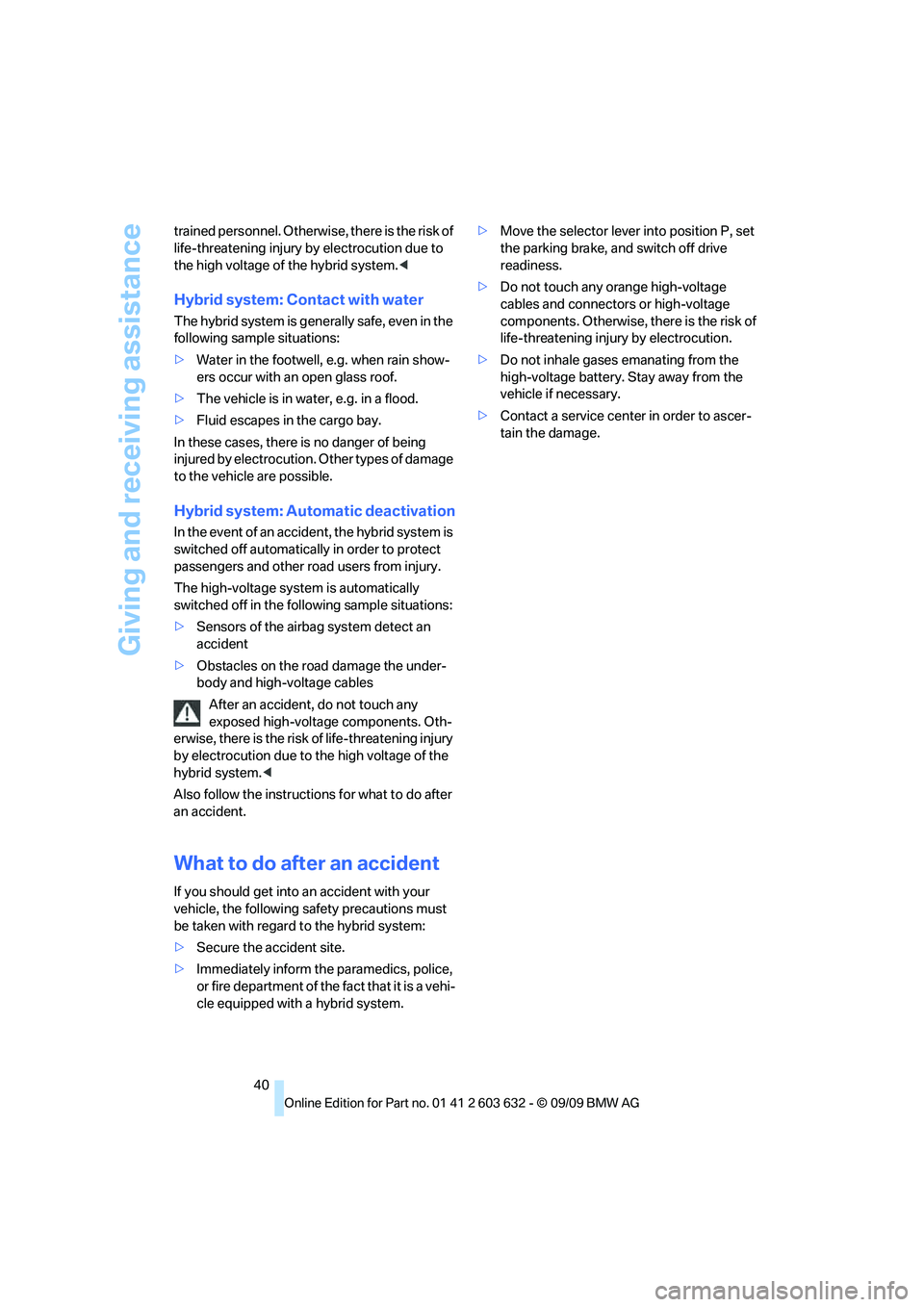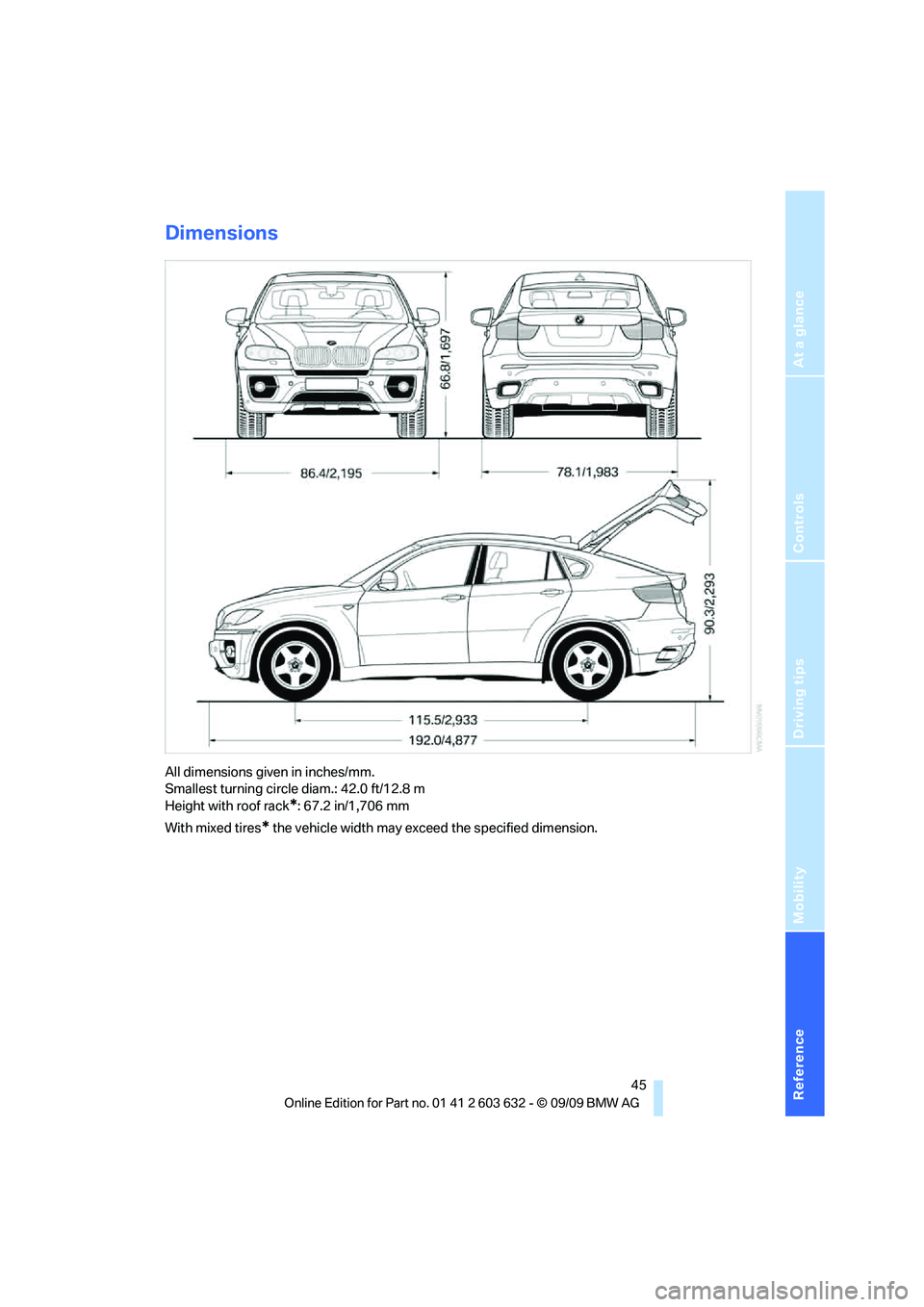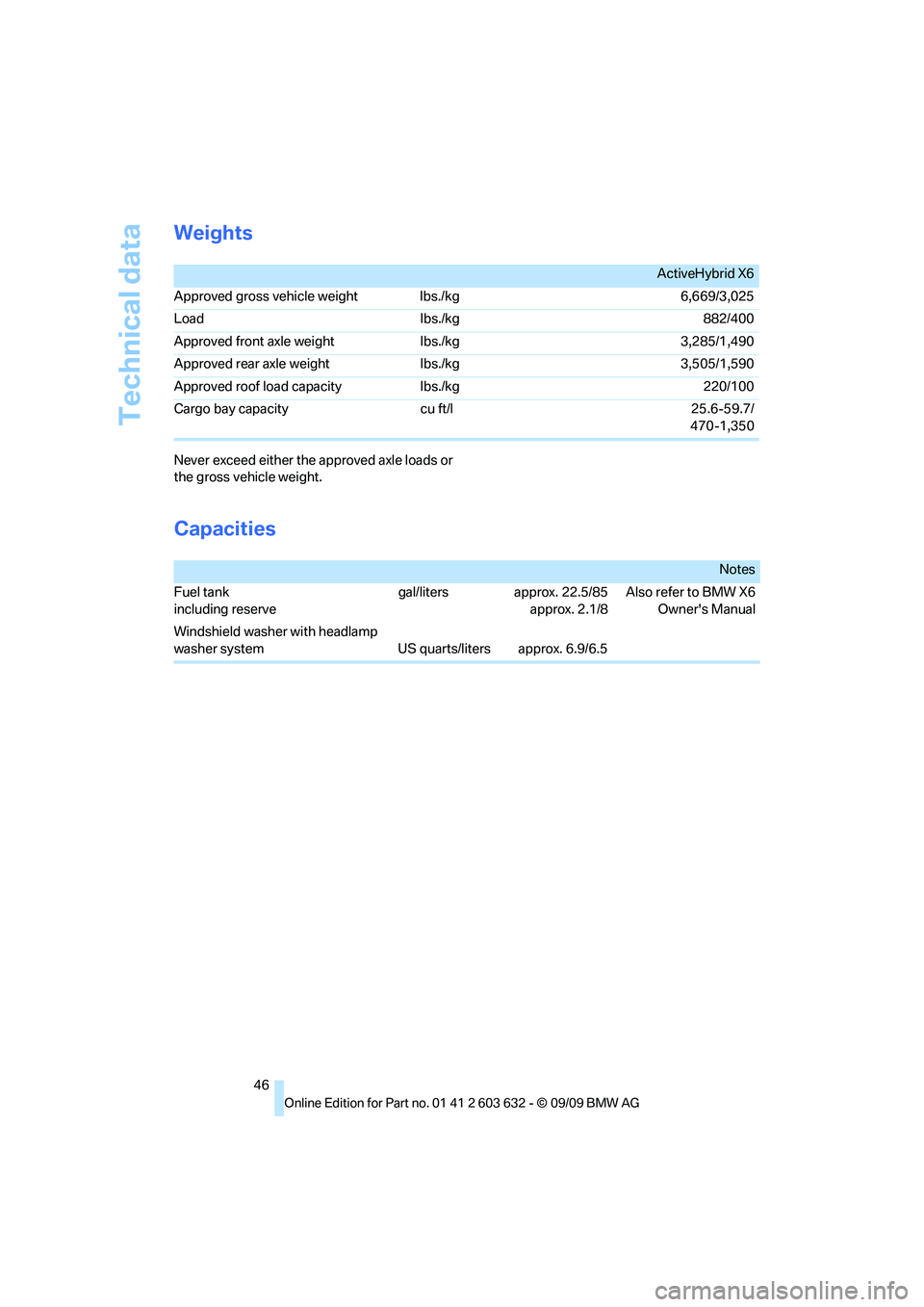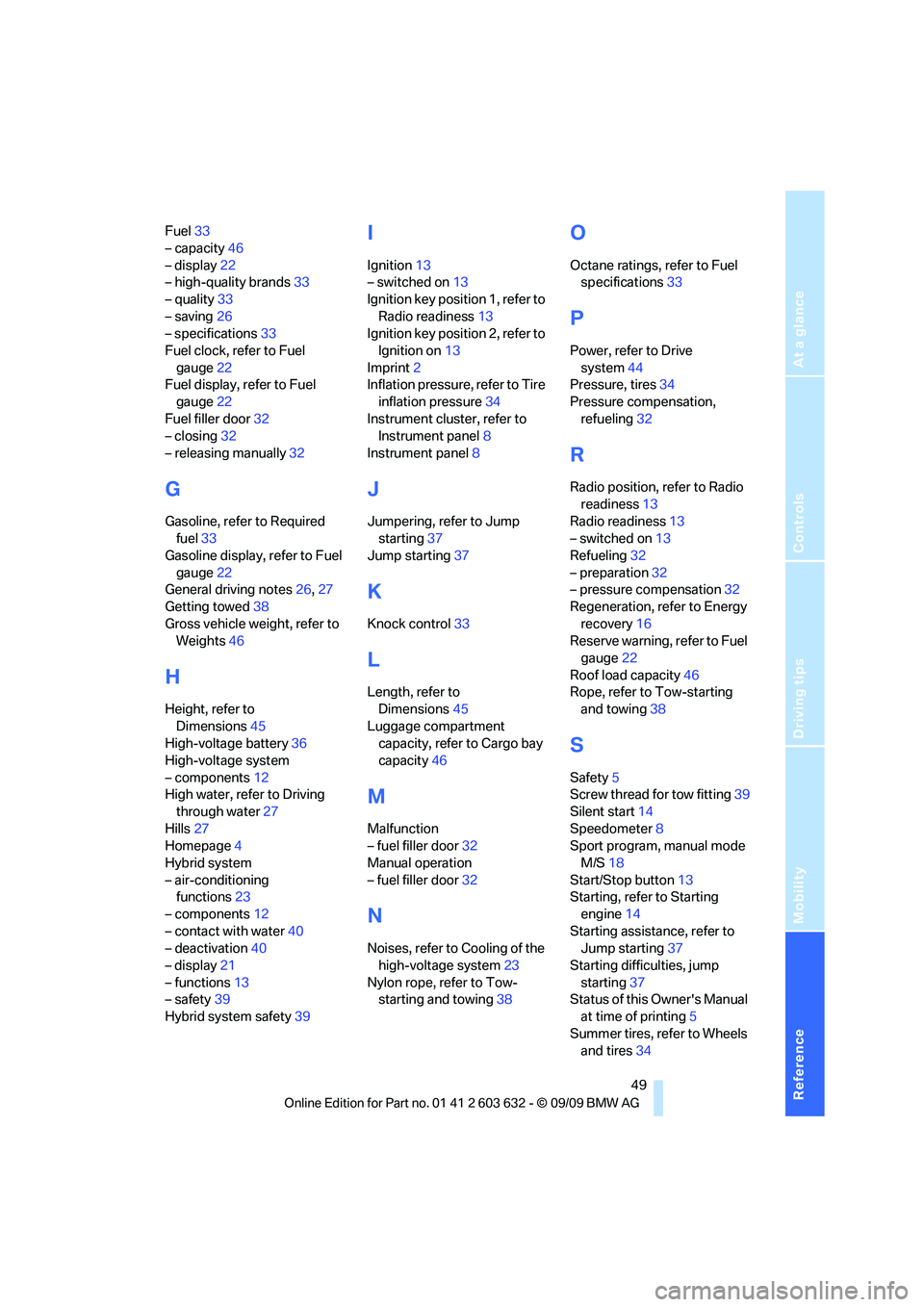roof BMW ACTIVEHYBRID X6 2010 Owners Manual
[x] Cancel search | Manufacturer: BMW, Model Year: 2010, Model line: ACTIVEHYBRID X6, Model: BMW ACTIVEHYBRID X6 2010Pages: 54, PDF Size: 3.16 MB
Page 28 of 54

Things to remember when driving
26
Things to remember when driving
Break-in period
Moving parts need breaking-in time to adjust to
each other. To ensure that your vehicle contin-
ues to provide optimized economy of operation
throughout an extended service life, we request
that you devote careful attention to the follow-
ing section.
Engine and rear axle differential
Always obey all official speed limits.
Up to 1,200 miles/2,000 km
Drive at various engine and vehicle speeds, but
do not exceed:
>4,500 rpm or 100 mph/160 km/h
Avoid full-throttle operation and use of the
transmission's kick-down mode during these
initial miles.
From 1,200 miles/2,000 km
The engine and vehicle speed can gradually be
increased.
Brake system
Brakes require an initial break-in period of
approx. 300 miles/500 km to achieve optimized
contact and wear patterns between brake pads
and rotors. Drive in a reserved manner during
this break-in period.
Following part replacement
Observe the break-in instructions again if com-
ponents mentioned above must be replaced
after subsequent driving operation.
Saving fuel
The fuel consumption of your vehicle depends
on various factors. Through a few simple steps,
your driving style, and regular maintenance, you
can have a positive influence on your fuel con-
sumption and environmental impact.
Removing unnecessary cargo
Additional weight increases fuel consumption.
Removing add-on parts after use
Remove unneeded auxiliary mirrors, roof or rear
luggage racks after use. Add-on parts attached
to the vehicle impede the aerodynamics and
increase the fuel consumption.
Closing windows and glass sunroof*
An open glass sunroof or window likewise
increases air resistance and thus fuel consump-
tion.
Checking tire inflation pressures
regularly
Check and correct the tire inflation pressure as
needed at least twice a month and before long
trips.
An insufficient tire inflation pressure increases
the rolling resistance and thus increases the
fuel consumption and tire wear.
Driving off immediately
Do not allow the engine to warm up by leaving it
running while the vehicle remains stationary.
Instead, begin to drive at a moderate engine
speed. This is the fastest way for the cold
engine to reach its operating temperature.
Thinking ahead when driving
Avoid unnecessary acceleration and braking.
To do so, maintain the appropriate distance
from the vehicle in front of you. An anticipatory
and smooth driving style reduces fuel con-
sumption.
Avoiding high engine speeds
Driving at a low engine speed reduces fuel con-
sumption and minimizes wear.
Page 42 of 54

Giving and receiving assistance
40 trained personnel. Otherwise, there is the risk of
life-threatening injury by electrocution due to
the high voltage of the hybrid system.<
Hybrid system: Contact with water
The hybrid system is generally safe, even in the
following sample situations:
>Water in the footwell, e.g. when rain show-
ers occur with an open glass roof.
>The vehicle is in water, e.g. in a flood.
>Fluid escapes in the cargo bay.
In these cases, there is no danger of being
injured by electrocution. Other types of damage
to the vehicle are possible.
Hybrid system: Automatic deactivation
In the event of an accident, the hybrid system is
switched off automatically in order to protect
passengers and other road users from injury.
The high-voltage system is automatically
switched off in the following sample situations:
>Sensors of the airbag system detect an
accident
>Obstacles on the road damage the under-
body and high-voltage cables
After an accident, do not touch any
exposed high-voltage components. Oth-
erwise, there is the risk of life-threatening injury
by electrocution due to the high voltage of the
hybrid system.<
Also follow the instructions for what to do after
an accident.
What to do after an accident
If you should get into an accident with your
vehicle, the following safety precautions must
be taken with regard to the hybrid system:
>Secure the accident site.
>Immediately inform the paramedics, police,
o r f ir e d e p a r t m e n t o f t h e f a c t t h a t i t i s a v e h i-
cle equipped with a hybrid system.>Move the selector lever into position P, set
the parking brake, and switch off drive
readiness.
>Do not touch any orange high-voltage
cables and connectors or high-voltage
components. Otherwise, there is the risk of
life-threatening injury by electrocution.
>Do not inhale gases emanating from the
high-voltage battery. Stay away from the
vehicle if necessary.
>Contact a service center in order to ascer-
tain the damage.
Page 47 of 54

Reference
At a glance
Controls
Driving tips
Mobility
45
Dimensions
All dimensions given in inches/mm.
Smallest turning circle diam.: 42.0 ft/12.8 m
Height with roof rack
*: 67.2 in/1,706 mm
With mixed tires
* the vehicle width may exceed the specified dimension.
Page 48 of 54

Technical data
46
Weights
Never exceed either the approved axle loads or
the gross vehicle weight.
Capacities
ActiveHybrid X6
Approved gross vehicle weight Ibs./kg 6,669/3,025
Load Ibs./kg 882/400
Approved front axle weight Ibs./kg 3,285/1,490
Approved rear axle weight Ibs./kg 3,505/1,590
Approved roof load capacity Ibs./kg 220/100
Cargo bay capacity cu ft/l 25.6-59.7/
470-1,350
Notes
Fuel tank
including reservegal/liters approx. 22.5/85
approx. 2.1/8Also refer to BMW X6
Owner's Manual
Windshield washer with headlamp
washer system US quarts/liters approx. 6.9/6.5
Page 51 of 54

Reference
At a glance
Controls
Driving tips
Mobility
49
Fuel33
– capacity46
– display22
– high-quality brands33
– quality33
– saving26
– specifications33
Fuel clock, refer to Fuel
gauge22
Fuel display, refer to Fuel
gauge22
Fuel filler door32
– closing32
– releasing manually32
G
Gasoline, refer to Required
fuel33
Gasoline display, refer to Fuel
gauge22
General driving notes26,27
Getting towed38
Gross vehicle weight, refer to
Weights46
H
Height, refer to
Dimensions45
High-voltage battery36
High-voltage system
– components12
High water, refer to Driving
through water27
Hills27
Homepage4
Hybrid system
– air-conditioning
functions23
– components12
– contact with water40
– deactivation40
– display21
– functions13
– safety39
Hybrid system safety39
I
Ignition13
– switched on13
Ignition key position 1, refer to
Radio readiness13
Ignition key position 2, refer to
Ignition on13
Imprint2
Inflation pressure, refer to Tire
inflation pressure34
Instrument cluster, refer to
Instrument panel8
Instrument panel8
J
Jumpering, refer to Jump
starting37
Jump starting37
K
Knock control33
L
Length, refer to
Dimensions45
Luggage compartment
capacity, refer to Cargo bay
capacity46
M
Malfunction
– fuel filler door32
Manual operation
– fuel filler door32
N
Noises, refer to Cooling of the
high-voltage system23
Nylon rope, refer to Tow-
starting and towing38
O
Octane ratings, refer to Fuel
specifications33
P
Power, refer to Drive
system44
Pressure, tires34
Pressure compensation,
refueling32
R
Radio position, refer to Radio
readiness13
Radio readiness13
– switched on13
Refueling32
– preparation32
– pressure compensation32
Regeneration, refer to Energy
recovery16
Reserve warning, refer to Fuel
gauge22
Roof load capacity46
Rope, refer to Tow-starting
and towing38
S
Safety5
Screw thread for tow fitting39
Silent start14
Speedometer8
Sport program, manual mode
M/S18
Start/Stop button13
Starting, refer to Starting
engine14
Starting assistance, refer to
Jump starting37
Starting difficulties, jump
starting37
Status of this Owner's Manual
at time of printing5
Summer tires, refer to Wheels
and tires34